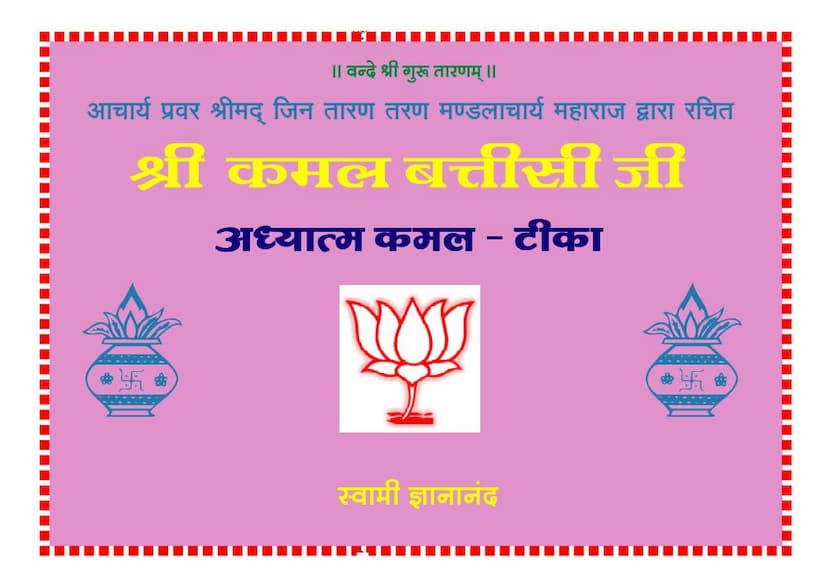Kamal Battisi
Added to library: September 2, 2025
Loading image...

Summary
This comprehensive summary details the Jain text "Kamal Battisi" by Gyanand Swami, a commentary on the work of Acharya Jin Taran Tarana Swami. The text, published by Bramhanand Ashram, focuses on the concept of Samyak Charitra (Right Conduct) as the path to liberation.
Key Themes and Content:
- Core Jain Philosophy: The text emphasizes the Jain principles of Samyak Darshan (Right Faith), Samyak Gyan (Right Knowledge), and Samyak Charitra (Right Conduct) as the fundamental pillars of the path to liberation (Moksha).
- The Role of Acharya Jin Taran Tarana Swami: Acharya Jin Taran Tarana Swami is presented as a revolutionary spiritual figure of the 16th century who advocated for pure spirituality, transcending outward rituals and false practices. He is credited with authoring fourteen foundational texts, including "Kamal Battisi," which elucidate the path to spiritual upliftment.
- "Kamal Battisi" and Samyak Charitra: "Kamal Battisi" specifically expounds the significance of Samyak Charitra through 32 Gathas (verses). Samyak Charitra is defined as acting in accordance with one's true soul nature, transcending worldly attachments and emotions like desire, hatred, and delusion. It is described as the gateway to liberation, essential for attaining Moksha, even for Tirthankaras.
- Commentary by Gyanand Swami: Swami Gyananand provides an insightful commentary on the "Kamal Battisi," clarifying the profound meanings within Taran Swami's verses in simple and accessible language. His commentary is rooted in his own spiritual experiences and understanding.
- The Symbolism of the Lotus: The title "Kamal Battisi" (Lotus Thirty-Two) is explained through the symbolism of the lotus. Like the lotus that remains pure and untouched amidst mud and water, the enlightened soul remains detached from worldly impurities and experiences even while living in the world. The name also connects to Taran Swami's birthplace, Pushpavati, where lotuses are abundant.
- Distinguishing True Dharma from Rituals: The text strongly differentiates true Dharma from mere external rituals, actions, or austerities. It clarifies that mere outward practices without the inner realization of the soul's true nature do not lead to liberation. True Dharma lies in dwelling in the pure, blissful, and conscious nature of the soul (Shuddhatma).
- The Danger of Misinterpreting Knowledge: The commentary warns against misinterpreting spiritual knowledge (Tattvanya or Tatva Nirnaya) as a license for unrestrained behavior or self-indulgence. True knowledge leads to detachment (Vairagya) and control over senses and desires, not to self-centered actions disguised as spiritual understanding.
- The Importance of Inner Transformation: The core message is about internal transformation rather than external show. The text emphasizes controlling the mind, shedding attachments, and realizing the true, pure, and blissful nature of the soul.
- Practical Guidance and Structure: The commentary is structured to provide clarity, often using questions and answers (Prashnottar), explanations of word meanings (Shabdarth), and special insights (Vishesharth) to enhance understanding. The flow from one Gatha to the next is maintained through interconnected themes.
- The Path to Purity: The text details how to achieve purity of consciousness, the shedding of karmic bonds, and the attainment of the Arhant and Siddha states, culminating in the experience of the Paramatma (Supreme Soul) and eternal bliss.
- The Role of Faith and Diligence: It highlights the importance of unwavering faith in Tirthankara's teachings, consistent effort (Purushartha), and diligent practice to overcome obstacles and achieve the ultimate goal.
- The Significance of the Commentator and Publisher: The publication of this commentary by Brahmavarchas Ashram is seen as a significant contribution to Jain literature and spiritual propagation. The text also acknowledges generous donations and efforts that contributed to its publication.
- The "Jagaran Geet" and Devotional Songs: The inclusion of devotional songs like the "Jagaran Geet" further emphasizes the spiritual essence and call to awakening within the text.
In essence, "Kamal Battisi," with Gyananand Swami's profound commentary, serves as a guide to understanding and practicing Samyak Charitra, leading the soul towards its inherent state of purity, bliss, and liberation, as envisioned by Acharya Jin Taran Tarana Swami and the core tenets of Jainism.